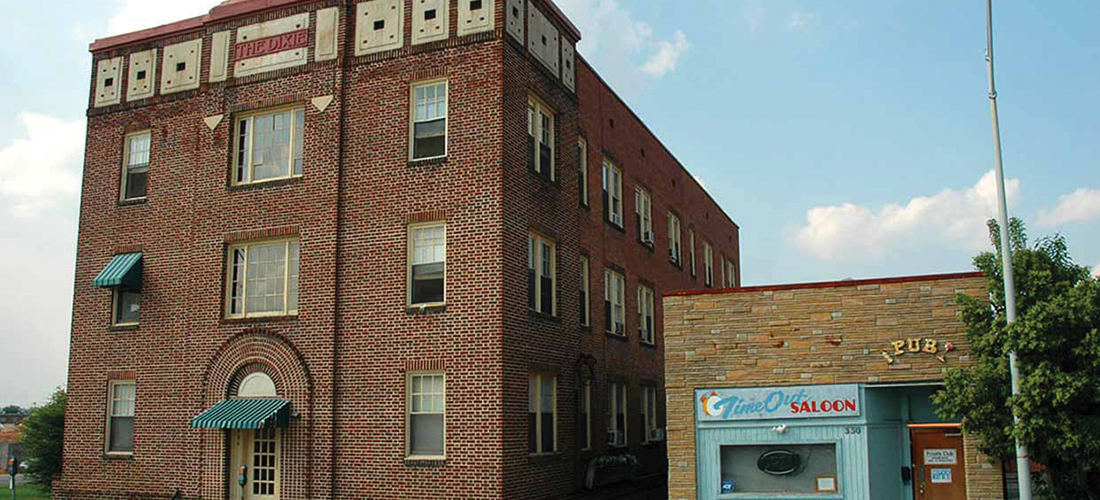
The Day They ʼDozed Old Dixie Down
By Billy Eye
The past is never dead. It’s not even past. — William Faulkner
In 1997, I moved downtown, just a couple of blocks west of Hamburger Square. Anytime I told someone where I was living, their faces would scrunch into a look of genuine astonishment, “Why would you do that? There’s no one down there but bums,” they’d each say.
For the most part that was true. I recall a time in ’98 when friends visited from Detroit. As we were touring the empty storefronts and abandoned restaurants downtown, my friends wondered if a nuclear bomb had gone off. On a Friday at 5 p.m., we encountered not a single car on the street and, when a truck finally did speed by, “Welcome to Greensboro!” wasn’t even close to what they shouted at us.
In the ’90s, about the only action downtown at night (or during the day for that matter) was the Paisley Pineapple sofa bar where Natty Greene’s is today and, a few blocks north on Elm, a notorious rave club known as Babylon. There also was the funky-time apartment building on Bellemeade and Eugene where many of Babylon’s hopped-up, whirling dervishes spun down, The Dixie.
The Dixie began life in 1888 as a tobacco warehouse erected by businessman W.W. Dick on Bellemeade Street at the northwest outskirts of a burgeoning Greensborough. It wasn’t long before a lovely, shaded neighborhood of finely crafted, single-family homes sprang up around that warehouse, so, sensing a need for such a thing, in 1921 Dick converted the building into the handsomest apartment complex in town, three stories fronted with levels of multicolored bricks expanding outward, a fanciful array of red bricks splaying outward around the entryway.
Crowned by bold, squared-off, concrete ornamentations, with ribbed metal awnings adorning each window, modern amenities included built-in ironing boards, hot water radiators, and a chute for ice delivered daily to keep food cooled in the ice box. Only the fourth such establishment in town, rent for a one-bedroom unit was $12 a month (about $186 in today’s dollars).
Single working women favored 336 Bellemeade, and no wonder — reasonable rent and jobs galore within walking distance. The El-Rees-So cigar factory was a stroll away, one of more than a dozen such stogie-oriented enterprises clustered around Hamburger Square, each employing a phalanx of female assemblers, the thinking being that male cigar rollers would be tempted to steal from the stash. There were so many cigars being produced by women in the 1920s that our city became one of the largest exporters of pre-rolled tobacco products in the world.
By the 1950s, the rapid expansion of businesses across downtown Greensboro rolled like a wave around the now centrally located Dixie, a tsunami of commerce and concrete wiping out swathes of neighboring houses in favor of service stations, office buildings and the towering O.Henry Hotel.
Hundreds of jobs traditionally awarded exclusively to men were providing fresh opportunities for women in the workplace. Employment could be found at the center city’s massive S&W and Mayfair cafeterias, slinging hash at greasy spoons like Dee’s Grill, whipping up malteds at Lanier’s Soda Shop, in addition to a plethora of hotel, department and drug-store sales and lunch-counter positions. There were at least two dozen coffee shops alone within a five-block radius of The Dixie in the early 1950s. Sears and Roebuck’s retail showroom and Burlington Industries’ headquarters were directly across the street. It was a gradual and deliberate transition but, beginning in the 1950s, as the last remaining men moved out, The Dixie became an almost all-female community.
Over the next four decades, as tenants aged out and vacated, younger male and female tenants began gravitating toward The Dixie.
“It was cheap,” former resident (1995-1999) Chis Kennedy breaks it down. “The rent was like $300 and it was right downtown. If I needed to, I could walk to two of my jobs because I worked at Babylon and Paisley Pineapple.” During the 1990s, The Dixie was populated by single, young and middle-aged stoners; artists; programmers; and maladjusted Bukowski clones. Walking the hallways, visitors were greeted with the aroma of marijuana, cigarette smoke, stale beer and the unmistakable pungency of overflowing cat boxes.
“It was mostly young people in their 20s,” Kennedy says. “I was in the rave scene with all these people. Pretty much everybody in the counter-culture scene lived there at some point or another.” The younger tenants appreciated The Dixie for what it was — an antiquated relic of a bygone era with loads of character. “Everybody had really nicely decorated and painted apartments. The owners didn’t seem to care what you did to them,” he says.
You know how old folks like to reminisce about life being so safe back in the day that no one locked their front doors? The entrance to The Dixie was never locked either. While that made sense in earlier times, by the 1990s homeless folks were lining the hallways in the wintertime. Not that anyone seemed to mind. The fire escape clung so precariously to the back of the building, anyone with any sense would have taken their chances with the fire. You would have had to anyway; the door to the fire escape was locked tight.
“There were a lot of colorful stories about the building, that’s for sure,” Kennedy says. Unfortunately, given the genteel nature of this magazine, I can’t tell you a single one of them — not about the girl who haunted Kennedy’s apartment, the Mafia snitch who mysteriously overdosed, what went on in the alleyway after hours — none of it. My impression of The Dixie from the numerous parties I attended during the same period Kennedy lived there in the mid- to late-’90s was one of community. The Dixie was there to help launch someone on to better things or wallow in the quicksand one had created.
Residents were known to frequent the joint next door at 300 Bellemeade, a one-story dump with a somewhat colorful history at its nadir. Originally constructed as an overflow office for Burlington Industries in the 1940s, sometime in the ’80s it was gutted and reemerged as a cavernous, hole-in-the-wall, gay bar called Busby’s Tavern. In the late ’90s, 300 Bellemeade morphed into a delightfully weird hangout where many a coin vanished. In the City Directory it was listed as Aitch’s Toys and Games, but it was primarily a dive bar where the proprietor dazzled beer-sodden barflies with his sleight of hand surrounded by rubber chickens, collapsable top hats, marked cards and whoopee cushions. In the 2000s, that space became a gay bar for women, Time Out.
Around 2008, with nearby businesses and eateries thriving and the recently opened ballpark across the street drawing crowds, suddenly living downtown became hip, creating a housing boom. Although The Dixie had fallen into disrepair and ill-repute, it was, nonetheless, the last bastion of Bohemia remaining at the center of the city. If I’m not mistaken, it was the oldest apartment complex in Greensboro, when in 2014, this grande dame of the displaced along with the block of structures alongside her were reduced to rubble for the Hyatt Place Hotel and the accompanying Carroll at Bellemeade luxury apartments. OH
Correction: Eye goofed, misidentifying a photo in last month’s column! “FYI, the photo on page 37 above the article about the Star Theatre is not Grimsley students in 1978. That photo is the Page High School Junior Civitan Club taken circa 1971 for the yearbook. Most of them are seniors, Class of 1971, and I knew nearly all of them. The ‘gentleman’ in the hat, leaning on a crutch, is the class president, Charles Robinson, whom I married in 1975. Though someone misidentified the photo, I enjoyed seeing it again after 50 years.” — Chris Garton





